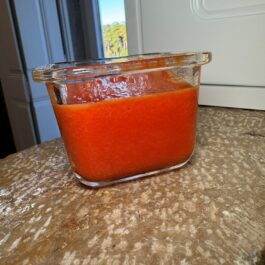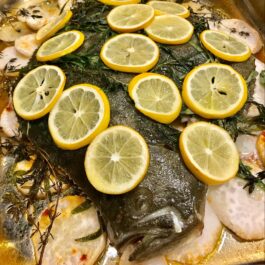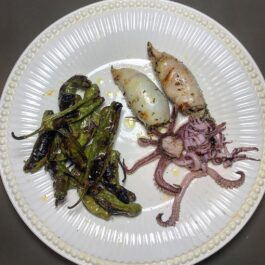Baked Turbot Fish
Baked turbot is a prized dish known for its delicate yet rich flavor, often prepared with simple techniques that highlight the quality of the fish. One of the most revered ways to cook turbot is by drawing inspiration from the grilling traditions of the Basque Country, where seafood is treated with respect and precision. In this region, particularly in coastal fishing towns like Getaria, turbot is traditionally grilled whole over an open flame, allowing its natural gelatinous texture and deep oceanic flavors to shine through. However, when baked, similar principles can be applied—minimal seasoning, careful temperature control, and an emphasis on preserving the fish’s natural juiciness.
A standout establishment that has elevated turbot to an art form is Restaurante Elkano, a Michelin-starred institution in Getaria renowned for its mastery of seafood grilling. The restaurant, founded by Pedro Arregui, has perfected the technique of cooking turbot whole on an outdoor grill, skillfully basting it with its own juices and ensuring that the skin crisps while the flesh remains tender and succulent. When we visited this restaurant we were delighted to try the grilled turbot for ourselves. The food was spectacular. Living in an urban apartment we adapted this Basque approach to baking, replicating the effect by roasting the fish at high heat, allowing the skin to crisp while basting it with a simple emulsion of olive oil, garlic, and its own rendered juices. This method preserves the fish’s natural flavors and gelatinous qualities, much like the renowned grilled version.
The beauty of baked turbot lies in its simplicity—by using minimal ingredients and respecting traditional Basque techniques, the dish retains the pure essence of the sea. Whether grilled over an open flame at Elkano or baked in an oven at home, turbot is best enjoyed with light accompaniments such as roasted vegetables or a citrus-infused sauce to enhance its buttery richness. The influence of Basque grilling, with its focus on high-quality ingredients and masterful control of heat, ensures that this dish remains a timeless celebration of the ocean’s bounty.
Turbot is flavorful and rich so we stick to simple seasonings such as salt, pepper, tarragon, and lemons, while also incorporating Txakolina wine, which is a specialty to the Basque region. The resulting baked Turbot is delicious! Tarragon is a unique herb that pairs incredibly well with seafood, and in this dish infuses the baked Turbot with immense flavor. It is also somewhat of a show stopper when you present this mighty fish to your family and friends. We hope you enjoy!
Turbot is not a particularly common fish at the grocery store, but I have seen them at Eataly if one is near you, or you can check out Fresh Direct and they will deliver to your home.

Baked Turbot Fish
Ingredients
- 2 sliced meyer lemons
- Handful tarragon sprigs
- 1 cup Txakoli wine, 1/4 bottle, white basque wine
- olive oil, to coat bottom turnips and on top of fish
- salt, to taste
- pepper
- 1 tsp papika
- 3-4 turnips (or fennel, parsnip, potatoes), thinly slice 1/4 inch thick
Instructions
- Heat the oven to 235 C or 450 F.
- Slice lemons into thin rounds.
- In this version we placed vegetables on the bottom of the pan drizzled with oil, wine, and topped with herbs.
- Place the fish on top of the vegetables.
- Bake the fish for 35 minutes.
- Once the 35 minutes have elapsed, check on the fish for doneness. The skin should have some browning. If not fully cooked, place back in the oven in 5 minute increments until cooked through.
- To serve, the turbot has 4 fillets. Cut along the spine and with a large spoon or spatula separate the meat from the bones. Lift the fillet onto a plate. Start with the top two fillets, then pull the skeleton off of the bottom two fillets. The cheeks of the fish are especially delightful.
- Pour the juices from the pan into a small bowl and stir together. Serve the juices over top of the fish.




